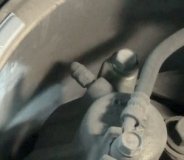This isn't exactly a do-it-yourself repair if you aren't familiar with all of the things that can go wrong, but the first step is to determine what is leaking. The rubber hose should be replaced if the outer casing is cracked or dry rotted. Often the brass line nut will round off or the line will snap off due to rust. That means you will also have to replace the steel line. If the steel line is rusted out, it may be easier to cut the line off at the brass nut, then use a 6-point socket to get the nut loose from the hose. If you use a torch to expand the metal end of the rubber hose, the hose will melt and pop out of the crimped end. Watch out for spraying hot brake fluid.
Check that the bleeder screw on the caliper is free. If it is rusted tight, pounding on the caliper housing to distort it slightly might free it up. You can also heat the screw red hot with a torch, then shock it with cold water on just the screw, not the entire caliper. There are also tricks to bleeding the air out of new lines and hoses that don't require getting the bleeder screw open.
Two real important things to watch out for: Do not use any type of penetrating oil to free up rusted parts. Any petroleum product that gets into the brake fluid will contaminate it and destroy ALL rubber parts in the system. The only proper repair is to replace all rubber hoses, and parts containing rubber seals and o-rings, and flush and dry all steel lines.
The second thing is to never ever push the brake pedal all the way to the floor. Debris and corrosion build up in the bottom half of the bores in the master cylinder where the lip seals don't normally travel. When a leak occurs, or when a helper runs the pedal all the way to the floor during the bleeding procedure, the seals run over that corrosion and can be torn. That will result in more work replacing the master cylinder and bench-bleeding it.
While the system is open for part replacement, gravity will cause the fluid to drain out of the reservoir. If you place a stick between the seat and the brake pedal to hold the pedal down about 2", fluid will stay in the reservoir. That will make air removal a lot easier.
Caradiodoc
Thursday, April 15th, 2010 AT 7:26 PM


